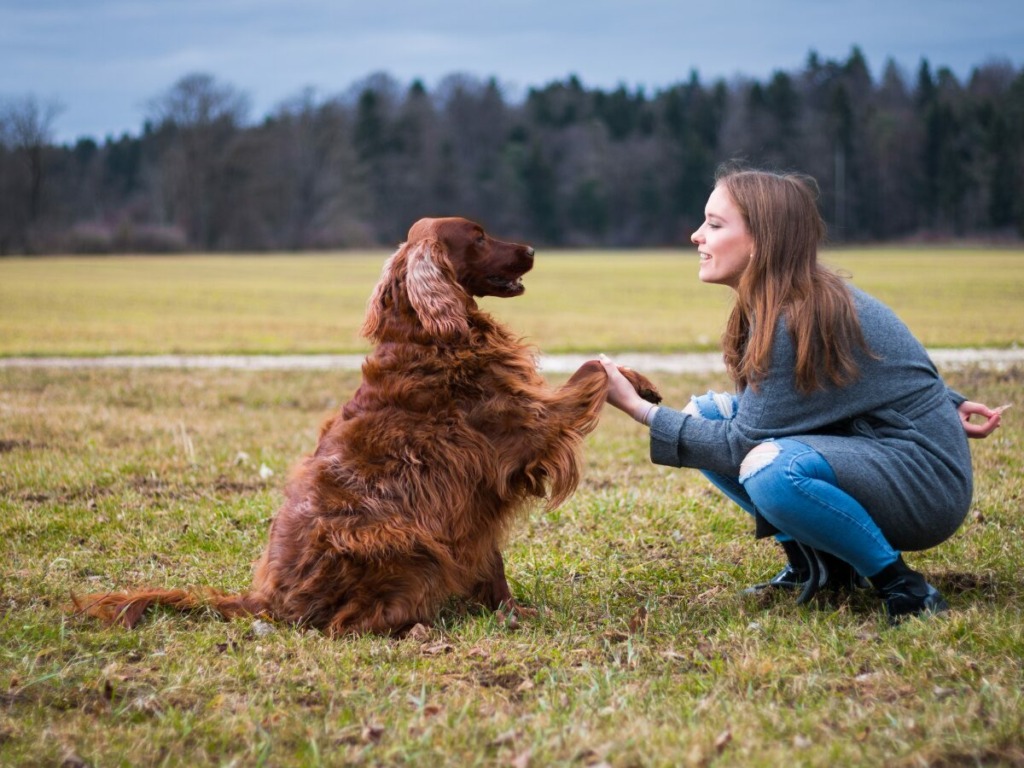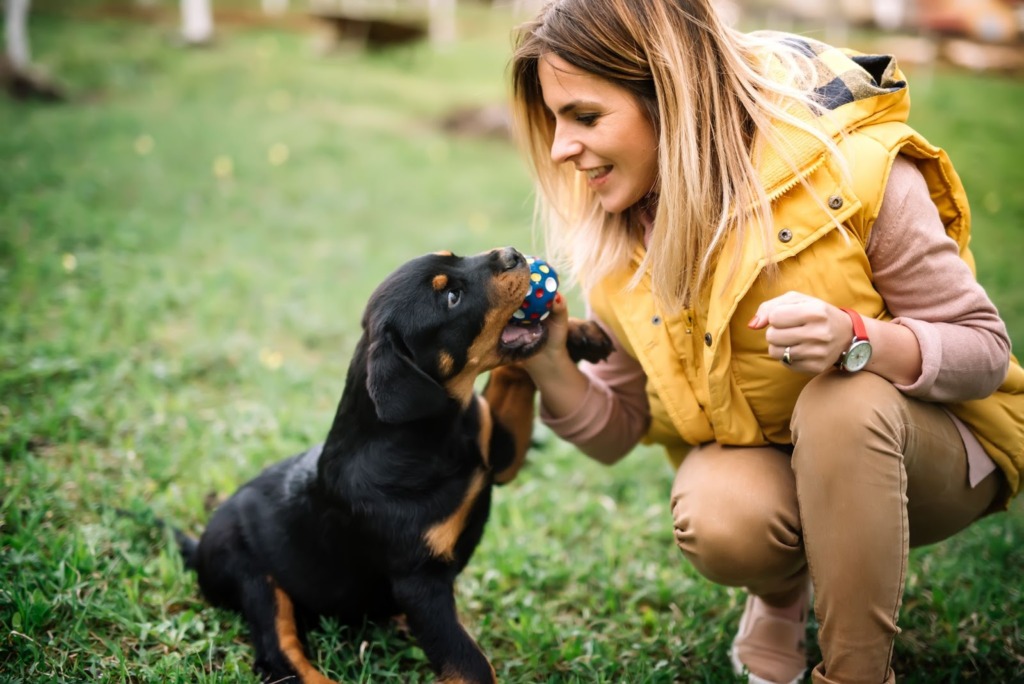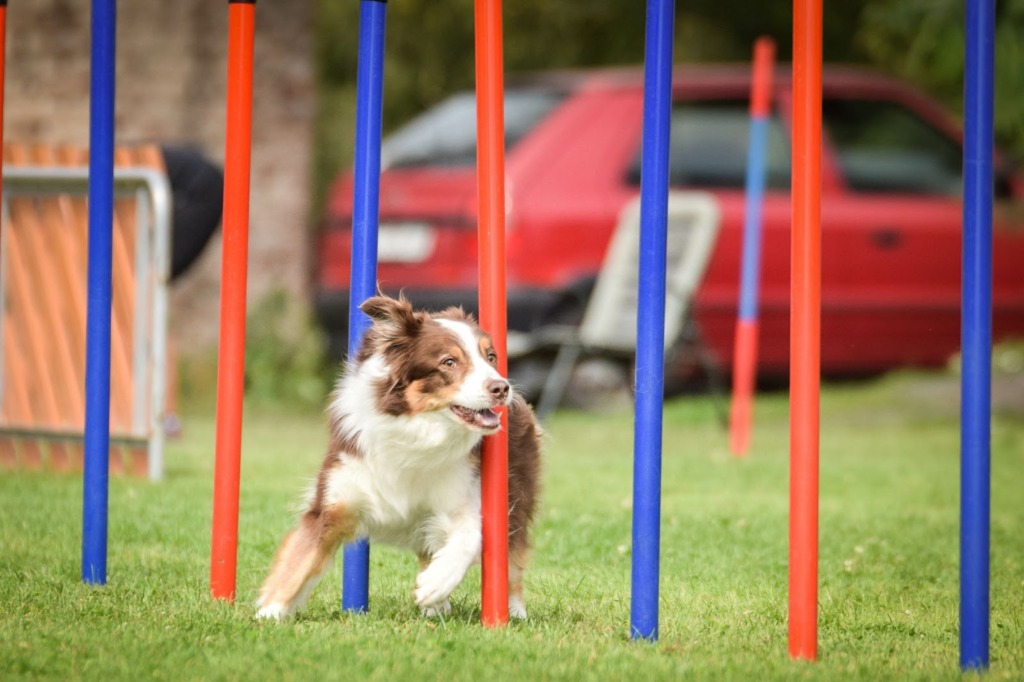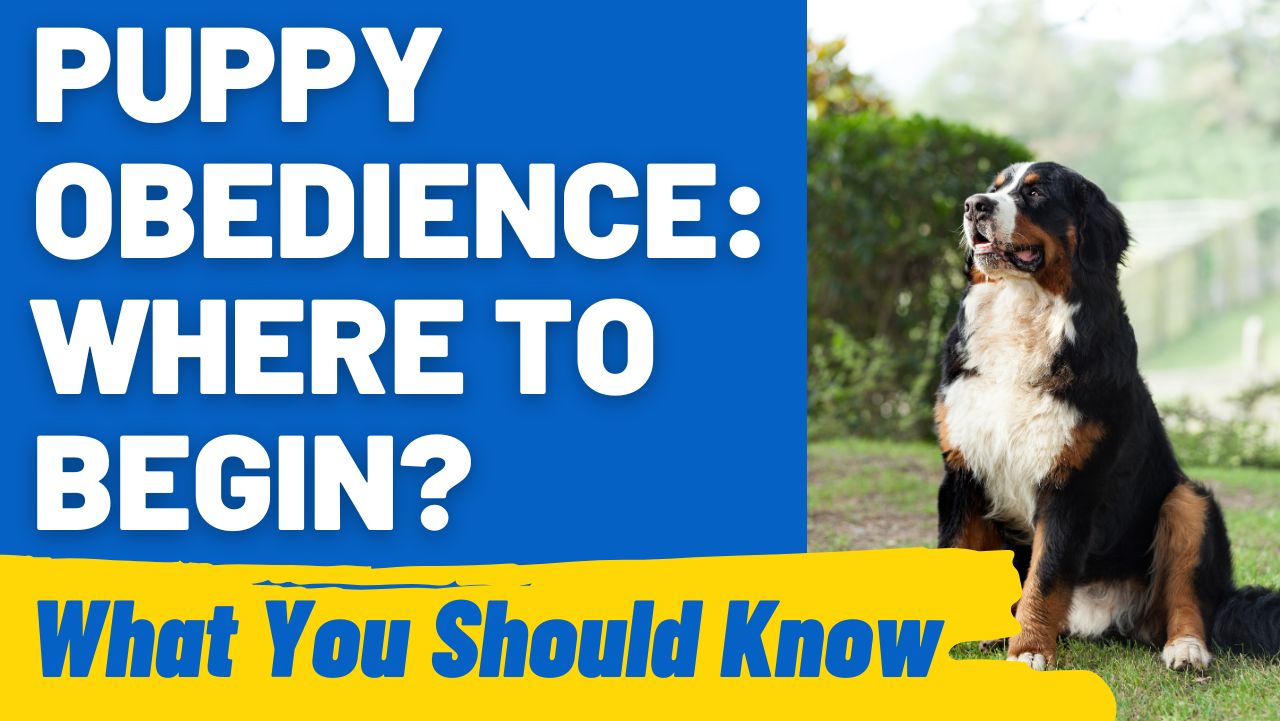Puppy obedience is more than just teaching commands. It’s about nurturing a relationship based on mutual respect and understanding. It lays the foundation for a well-behaved adult dog and ensures a harmonious life together.
In this beginner’s guide, we’ll outline what you can expect as you start this training process.
We’ll highlight the importance of early obedience training and give you a glimpse into the methods and rewards that await you and your puppy.
Let’s begin this joyous and fulfilling adventure in puppy obedience!
Why is Puppy Obedience Training Essential?

Puppy obedience training is much more than teaching your furry buddy to sit or stay. It’s about setting the stage for a lifetime of good behavior and a strong bond between you and your pup.
Let’s break down why puppy obedience is so critical:
- Safety First: Obedience training teaches your puppy essential commands, like ‘come’ or ‘stay,’ which can be lifesavers in dangerous situations. Imagine your pup darting towards a busy street; a well-timed “come” command could prevent a disaster.
- Building a Strong Bond: Training sessions are prime time for strengthening your relationship with your puppy. Through puppy obedience, you communicate, understand each other’s cues, and grow closer. It’s all about teamwork!
- Preventing Behavioral Issues: Start puppy obedience early to nip potential problems in the bud. It’s way easier to mold a young pup’s behavior than to correct issues in an adult dog.
- Social Skills: Obedience training is a gateway to socializing your puppy. It helps them learn how to behave around other dogs and people, which is key for a well-adjusted, sociable pooch.
- Mental Stimulation: Training challenges your puppy’s brain, keeping them mentally stimulated. A mentally engaged puppy is a happy, less destructive puppy.
Puppy obedience is an essential stepping stone in your dog’s development. It’s about safety, bonding, good behavior, and so much more.
So, when you start with puppy obedience, you’re setting the stage for a lifetime of good habits and mutual understanding.
When Should You Start Training Your Puppy?
When it comes to puppy training, timing is everything.
The golden window for starting puppy obedience training is as soon as they set paw into your home. Generally, this is around 8 to 12 weeks old.
Why so early, you ask? Well, puppies are like sponges at this age, soaking up everything around them, making it the perfect time to start shaping their behavior.
Starting early doesn’t mean diving into complex commands right away. It’s about laying the groundwork for basic obedience and socialization.
This early phase is crucial for their development. It’s when they learn to interact with the world, understand commands, and start forming a bond with you.
So, remember, the sooner you start with puppy training, the better. It sets a clear structure for your pup, making future training smoother. Plus, it’s a fun and rewarding way to kickstart your lifelong journey with your new best friend.
Early training helps prevent unwanted behaviors before they even start, making it a win-win for both you and your puppy!
What Are the Basic Commands Every Puppy Should Learn?
Diving into the training basics of puppy obedience, there are a few fundamental commands every pup should master. These aren’t just party tricks but are crucial for safety and everyday life.
Here’s a quick run-through:
- Sit: The cornerstone for teaching patience and control.
- Stay: Crucial for preventing your puppy from wandering into harm’s way.
- Come: A lifesaver for calling your puppy back in potentially dangerous situations.
- Heel: Keeps walks enjoyable and controlled, especially in busy areas.
- Leave it/Drop it: Essential for stopping your puppy from picking up harmful objects.
Interested in reading our post about What Are the First Commands to Teach Your New Pup? Start Training Right
Table: Basic Commands and Their Purposes
| Command | Purpose | How to Teach It |
| Sit | Control and discipline, useful in various situations | Hold a treat above their nose and gently push their bottom down while saying “sit”. Reward when they sit. |
| Stay | Safety and control, prevents bolting | After ‘sit’, step back, say “stay”, and reward for staying put. Increase distance gradually. |
| Come | Essential for recalling your puppy | Call “come” in a cheerful tone and reward when they approach. Start in a distraction-free area. |
| Heel | For controlled walking | Walk with your puppy, say “heel”, and reward them for staying by your side. |
| Leave it/Drop it | Prevents picking up/chewing dangerous items | Say “leave it” when they approach a forbidden item, and reward when they obey. |
Mastering these commands is a huge step in fostering a safe and respectful relationship with your puppy.
How Does Dog Behavior Influence Training?

When you’re in the thick of puppy obedience, understanding your furry friend’s behavior is like having a secret decoder ring. It’s not just about the ‘how’ of training, but also the ‘why’ behind their actions.
Knowing what makes your puppy tick can make all the difference in effective training.
First up, let’s talk about breed tendencies. Each breed has its quirks – some are natural herders, others expert sniffers, and then you have your cuddly lap warmers.
Recognizing your puppy’s breed-specific traits can guide your training approach. For instance, a Border Collie might need more mental stimulation during training, while a Beagle might be more scent-driven.
But, remember, it’s not all about the breed. Your puppy’s unique personality plays a huge role too. Some pups are bold adventurers, while others might be shy wallflowers.
Tailoring your training to match their temperament is key. A confident puppy might respond well to challenges, whereas a timid one might need more gentle encouragement and patience.
Understanding your puppy’s behavior, breed tendencies, and individual personality, helps you create a tailored training plan. It’s about working with their natural instincts, not against them.
What Are the Best Training Techniques for Beginners?
Embarking on puppy obedience training?
Here’s how to lay solid training foundations with beginner-friendly techniques:
- Short Training Sessions: Keep sessions brief (5-10 minutes) to match your puppy’s attention span.
- Focus on One Command at a Time: This helps avoid confusion and reinforces learning.
- Use Treats Effectively: Treats are powerful rewards. Use them wisely to encourage positive behavior.
- Stay Patient and Positive: Training takes time. A positive and patient approach is key.
- Utilize Body Language: Puppies are adept at reading body language, so use it to enhance training.
Positive Reinforcement: What Is It and Why Does It Work?
Positive reinforcement is a cornerstone in puppy training. It rewards desired behaviors, encouraging your puppy to repeat them.
When your pup follows a command, a treat or praise right afterward reinforces that behavior. This method is effective because it aligns with natural instincts—positive actions lead to positive outcomes.
Implementing it is straightforward: immediate rewards like treats or praise help your puppy understand what behaviors are desired.
The Role of Consistency in Training
Consistency is crucial in puppy training. It involves using the same commands, tone, and rewards, and establishing a clear, understandable pattern for your puppy.
Consistent training schedules are equally important, as setting a regular rhythm for learning. While flexibility is necessary, maintaining core training elements is essential for creating a stable, effective learning environment.
Remember, consistent training breeds familiarity and trust, making your puppy more open and responsive to learning.
Creating a Training Schedule: What Works Best?
Crafting a puppy obedience schedule is all about balancing your pup’s short attention span with consistent practice. The trick is to integrate training into your daily routine in manageable chunks, ensuring it’s neither overwhelming for your puppy nor you.
Sample Puppy Training Schedule
- Morning Routine: A quick 5-minute session after breakfast, focusing on simple commands like ‘sit’ or ‘stay’.
- Midday Break: Use this time for a 10-minute training play, introducing a new command or reinforcing the morning’s lessons.
- Evening Wind-Down: Post-dinner is perfect for a relaxed 10-minute recap of the day’s training.
- Bedtime: End the day with a brief 5-minute session, practicing a command your puppy enjoys.
This schedule is flexible. Feel free to tweak it based on your puppy’s energy and your availability. Consistency is key, but so is keeping training fun and stress-free for your furry friend.
Should You Consider Professional Puppy Classes?
Regarding puppy obedience, sometimes a little professional help can go a long way.
Enrolling in puppy classes has its perks. It’s not just about learning the basics; it’s an opportunity for your pup to socialize with other dogs and people. This early socialization is crucial for developing a well-rounded, confident dog.
But, like everything, there’s another side to the coin. Puppy classes require a commitment of both time and money. And sometimes, the one-size-fits-all approach may not suit every puppy’s unique needs or personality.
So, should you sign up? Consider your lifestyle, your puppy’s temperament, and what you’re hoping to achieve.
If you’re looking for structured learning and social opportunities, puppy classes are a great choice. But if you prefer a more tailored approach, one-on-one sessions with a trainer might be more up your alley.
Whichever route you choose, remember, it’s all about creating a positive learning experience for your furry friend.
How to Address Canine Discipline and Behavior Management?
Navigating discipline in puppy obedience is all about balance. It’s crucial to combine firmness with kindness.
Effective discipline means setting clear boundaries in a consistent, understandable manner. It’s about guiding your puppy towards acceptable behaviors and away from the not-so-good ones.
Common Behavioral Issues and Solutions
- Chewing: Redirect chewing to appropriate toys. Keep tempting items out of reach.
- Barking: To address excessive barking, first try to understand the cause. A distraction technique, like a noise from a Bark Corrector, can be effective in refocusing your pup’s attention.
- Jumping Up: Give attention only when all four paws are on the ground.
- Biting: Offer chew toys and discourage biting with a firm ‘no’ during play.
- Potty Training: Maintain a consistent bathroom schedule and praise successful outside trips.
Discipline in puppy training is about patience, consistency, and understanding. It’s a learning curve for both you and your puppy, one that builds trust and strengthens your bond.
Beyond the Basics: Where to Go After Mastering Fundamentals?

Once your puppy has the puppy obedience basics down, it’s time to explore more advanced and exciting training avenues.
Here’s what you can venture into:
- Advanced Commands: Step up with commands like ‘roll over’ or ‘shake’. It’s fun and mentally stimulating for your pup.
- Agility Training: Great for physical exercise and mental sharpness. Plus, it’s a blast for both of you.
- Specialized Classes: Explore courses in scent work, therapy dog training, or even trick training for a special twist.
- Canine Good Citizen (CGC) Program: Aim for this certification that focuses on good manners and social skills.
These steps not only enhance your puppy’s skills but also deepen the bond you share. Each offers a unique challenge and a chance for more fun and learning together.
Conclusion
Embarking on the puppy obedience journey is a wonderful adventure filled with learning and bonding. As you navigate this path, remember, that patience and love are your guiding stars.
Each training session is a step towards a stronger relationship with your furry companion. Celebrate the small wins and learn from the challenges.
This journey isn’t just about teaching your puppy. It’s about growing together. Embrace each moment with your pup, and you’ll find the process as rewarding as the results.
Here’s to the delightful adventure of puppy training, where every day brings new joys and a deeper bond with your beloved pet.
Enhance Your Puppy Training Journey with HoundGames
Ready to take your puppy obedience journey to the next level? Visit HoundGames for an array of engaging dog toys that do more than just entertain.
Our toys are designed to enrich your dog’s life, providing both mental stimulation and physical exercise.
But we’re not just about playtime. We’re committed to strengthening the bond between you and your furry friend. Dive into our expert insights and resources tailored for dog owners.
Whether it’s a new training tool or a fun toy to reward your pup, HoundGames is here to support you and your dog every step of the way.
Let’s make every moment with your dog count!




